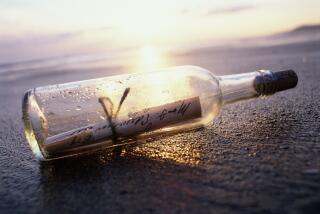What the ocean spits back out
- Share via
IN late 1990, hundreds of Nike shoes began washing up on the beaches of Vancouver Island and Queen Charlotte Sound. They were relatively new shoes, and local flotsamists amassed a substantial collection of them. There was only one problem: The majority of shoes pulled from the wrack were right-footed. Meanwhile, farther south, in Cannon Beach, Ore., other Nikes were appearing, most of them left-footed. Beachcombers up and down the Pacific Northwest were scratching their heads.
W. James Ingraham and Curtis C. Ebbesmeyer, oceanographers who track flotsam to better understand ocean currents, stepped in to decipher the source of the mismatched shoes. A container vessel, Hansa Carrier, en route from Korea to the United States in May 1990, had encountered severe weather in the North Pacific and lost 21 of its containers overboard, five of which held about 80,000 Nikes.
The shoes drifted for more than 200 days, hitching a ride on the Pacific’s currents; the right-footed ones tacked northeastward into the Alaska Current, while the left-footers joined the California Current. This “spill of opportunity,” although surely a headache for Nike and the insurers of Hansa Carrier, resulted in a boon of data for Ingraham’s Ocean Surface Currents Simulation computer model.
All this and more is chronicled in Skye Moody’s fascinating “Washed Up: The Curious Journeys of Flotsam and Jetsam.” Moody’s subject is anything that floats on, sinks in or washes up from the sea ambergris, seed pods, driftwood, barnacles, beeswax and messages in bottles. She covers Taiwanese propaganda set adrift for the Chinese mainland, beached sea monsters, lost BMWs, floating glass balls and, of course, shipwrecks.
Though Moody approaches the world of natural flotsam with an amateur naturalist’s keen eye, the most gripping parts of the book revolve around man-made flotsam and jetsam -- garbage, that is. People who examine it carefully get an uncensored view of humanity. It’s a mirror, albeit a dirty one. Our detritus, ourselves. When you combine this theory of garbage with the caprice of the sea, you find yourself looking at a cheap plastic toy picked off the sand and wondering: What does this mean? The improbability of the toy reaching your beach elevates the significance of the find. Perhaps this is why Moody makes a distinction, early in “Washed Up,” between the casual beachcomber and the devoted flotsamist. Pretty shells wash up all the time -- a more impressive find is a pink plastic propeller. Moody’s focus on serendipity and on rediscovering common objects that have been stripped from their context makes her something of a modern-day cargo cultist.
Unfortunately, there’s the nagging issue of environmental disaster. Even as I appreciated Moody’s enthusiasm for her subject, I could not shake from my mind the sad fact that we’re filling our oceans with trash. Several chapters in “Washed Up” are devoted to the Great Garbage Patch, a massive carpet of floating debris in the middle of the North Pacific subtropical gyre (a giant circular current), estimated to contain millions of tons of non-biodegradable refuse.
Though much of the book’s pleasure comes from Moody’s unlikely inventories of items collected from beaches around the world, a list of flotsam encountered in the Garbage Patch is disturbing, to say the least: “a drum of hazardous chemicals, an inflated volleyball coated in goose-necked barnacles, a cathode-ray television tube (19-inch screen), an inflated truck tire mounted on its steel rim.... “ That’s not even the worst of it -- the bulk of the refuse consists of tiny pieces of plastic, which break down into “a viscous synthetic broth,” eventually entering the food chain and extinguishing various forms of sea life. I’ll never look at a pink plastic propeller the same way again.
Structurally, “Washed Up” isn’t sure whether it wants to be a miscellany or a narrative. Moody ends up employing the techniques of both, resulting in an uneven collage, stimulating for its leaps one moment, frustrating for its evasions the next. At times I found myself wishing she’d written an encyclopedia of flotsam (with footnotes) instead. Nevertheless, Moody has written a fascinating book on a relatively overlooked subject, drawing on a head-spinning variety of sources to transform a walk on the beach into a journey through history, oceanography and folklore, toward a renewed sense of wonder. *
More to Read
Sign up for our Book Club newsletter
Get the latest news, events and more from the Los Angeles Times Book Club, and help us get L.A. reading and talking.
You may occasionally receive promotional content from the Los Angeles Times.










